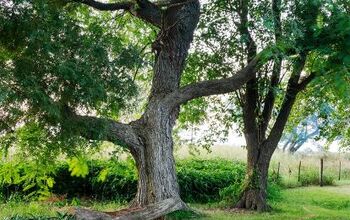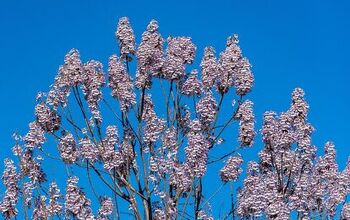What Are The Pros and Cons Of The Chinese Pistache Tree?

Native to the rocky hills of China, Taiwan, and the Philippines, the Chinese pistache tree is known for its signature umbrella shape and its brilliant fiery leaves in the fall. If you’re looking for a low-maintenance tree with ornamental properties for your xeriscape back, front, or side yard, the Chinese pistache tree will check all the boxes.
Nicknamed “The Ugly Duckling” of the gardening word, the Chinese pistache grows into quite the statuesque tree. Having one means you’ll have plenty of shade and a gorgeous display of autumnal coloration.
There are many pros and cons to the Chinese pistache tree.
The Chinese pistache tree is long-lived and extremely hearty. It provides excellent shade, and its leaves turn a brilliant orange-red in the fall, making it the perfect autumn tree. Unfortunately, planting a Chinese pistache tree also comes with some cons, including its susceptibility to root rot and verticillium wilt, its cold weather intolerance, and its rather awkward appearance before maturation.
There are many parts of the United States where the Chinese pistache tree will flourish. Read on to find out if your backyard needs one!
Related Content: What Is A Good Tree To Plant Near A House? | How Long Does It Take For A Tree To Grow? | Cheapest Time Of Year For Tree Removal
Do You Need Landscaping Services?
Get free, zero-commitment quotes from pro contractors near you.

What Are The Pros Of A Chinese Pistache Tree?
With its brilliant leaves, hearty root system, and widespread canopy, the Chinese pistache tree is a popular addition to backyards, parks, and gardens.
Longevity
The Chinese pistache tree can easily live to be 150 years old. Because they are so easy to care for, this tree could outlive you. The annual growth rate is around 13-24 inches per year. Because they’re so difficult to kill, the Chinese pistache tree is known as one of the most long-lasting trees in the gardening community.
The tree can grow to be as tall as 60 feet! If you plant both male and female pistache trees, the likelihood of their lasting a long time will increase. It’s considered a semi-fast growing tree that provides excellent shade for buildings that don’t exceed one story.
Take a look at these 7 Japanese wood types.
Sturdiness
Because Chinese pistache trees can withstand long periods of drought, they are very difficult to kill. They grow deep roots and only need to be watered when the top two inches of soil feels dry to the touch. When you first plant the tree, you’ll want to water at least 2 times a week, then back off as the tree grows.
This isn’t one of mother nature’s more picky trees. They are also tolerant to many different soil types. Pests are of little concern to a Chinese pistache tree; they can withstand just about every infestation and are even known to be fire resistant.
Easy Maintenance
The Chinese pistache tree doesn’t require a lot of shade. In fact, it needs at least 6 hours of direct sunlight a day. This makes the tree perfect for parks. Many parks in arid or desert regions of the U.S. plant Chinese pistache trees because of its inviting shade. Its canopy can stretch to be as wide as it is tall, for shading patios and walkways.
You’ll barely have to water a Chinese pistache tree. In fact, you forget one week, the tree won’t actually mind. It can withstand several days without watering. Over-watering is a problem for the Chinese pistache, but never under-watering. It’s the perfect tree for someone who just wants a plant to do its things without constant monitoring or fussing.
Pro Tip: Don’t plant a pistache tree too close to a building, house or path. Their roots and ever-growing canopy will keep spreading over time. It’s best to plant the Chinese pistache about 15 feet away from the nearest structure.
Check out these 15 types of dogwood trees.
Perfect For Xeriscape
Xeriscaping is a popular gardening technique in dry regions. It requires little to no irrigation or maintenance and is the perfect setting for the Chinese pistache tree. While xeriscaping is popular in places where freshwater is in short supply, it’s also becoming more and more common for homeowners who don’t necessarily have a green thumb.
Because of its extreme sturdiness, the Chinese pistache tree will flourish in a xeriscape garden. If you’re looking to add a splash of color to your xeriscape, the Chinese pistache will more than deliver.
How to plant a pistache tree:
- Step 1: Choose a spot with plenty of sun and fertile soil.
- Step 2: Dig a hole 3-5 times as wide as the tree’s root ball to accommodate for future growth.
- Step 3: Lightly tamp the dirt down and spread mulch around the base to discourage root rot.
- Step 4: Water twice a week for a month and then back off to once a week.
Stunning Autumn Color
One of the best parts of the Chinese pistache tree is its absolutely gorgeous fall leaves. In the spring and summer the tree has an array of waxy green leaves. It will blossom with reddish-green blooms that quickly turn to bluish-red berries.
These berries are a favorite of birds. Your tree will be full of them! The berries will eventually fall when the leaves are ready to shift shades with the changing of the season. The Chinese pistache leaves will fade from green to a fiery orange to a deep and vibrant red, giving it an opulent fall appearance.
What Are The Cons Of Chinese Pistache Trees?
Even though the Chinese pistache tree is probably one of the easiest trees to grow, that doesn’t mean it’s without its challenges.
Susceptible to Verticillium Wilt
While it can withstand a number of pests and infections, the Chinese pistache tree is particularly susceptible to verticillium wilt. Virticillium wilt is a fungal disease that lives in the soil. It will strike out of nowhere and can make leaves brown, wilt, and curl in on themselves.
Most often verticillium wilt will strike when temperatures are mild. It gets into the plant’s roots and is usually fatal. It’s best to toss the whole tree once it’s infected. You cannot plant anything else in that same spot until you’ve gotten rid of the verticillium wilt.
Chinese Pistache Root Rot
Because the Chinese pistache doesn’t need to be watered too regularly, over-watering or intense soil saturation will perpetuate root rot. Root rot is a fungus that will get into the roots of your plant, making them mushy and soft. They can’t pull the necessary nutrients from the soil and will cause the plant to slowly die off. Unfortunately, that’s why the Chinese pistache tree is best suited for dryer, more arid climates. If you live somewhere where you get a lot of rain, your tree most likely won’t last.
You can save young pistache trees from root rot, however.
Here are 4 steps to combat root rot:
- Step 1: Remove the plant and break off the soil from the root ball.
- Step 2: Trim away rotting roots.
- Step 3: Toss the infected soil.
- Step 4: Replant in fresh soil far from the infected area and make sure there’s good drainage.
Cold Weather Intolerance
Though the Chinese pistache tree is winter hardy up to 20 degrees, any colder and your tree will die. If you live somewhere with a lot of snow, you won’t want to plant a Chinese pistache tree. They really flourish with a lot of heat and not a lot of moisture. States like Texas, New Mexico, and Arizona are great for the Chinese pistache tree.
Awkward Appearance
The Chinese pistache tree didn’t earn the nickname “Ugly Duckling” out of nowhere. Young pistache trees are often spindly, gawky, and awkward. They grow in a vase-like shape. It will take awhile for the tree to actually fill out with its signature umbrella-shaped canopy. You’ll want to prune the branches accordingly as the tree matures. You might have some neighbors look sideways at your arboreal choice at first, but just hang in there!
Related Questions
Are Chinese Pistache Trees Messy?
For most of the year, Chinese pistache trees are so tame they go unnoticed. But once their berries drop, it can get pretty messy. Trampled pistache tree berries will get mushy and juicy and could stain sidewalks and porches. This is one of the reasons why it’s suggested to plant the tree at least 15 feet from the nearest structure.
How Tall Are Chinese Pistache Trees?
On average, a Chinese pistache tree will grow to be about 35 feet. They can certainly grow taller, but in the U.S. 35 feet is common.
Do You Need Landscaping Services?
Get free, zero-commitment quotes from pro contractors near you.

What’s The Verdict?
When weighing the pros and cons of adding a Chinese pistache tree to your garden, the pros vastly outweigh the cons. Low maintenance, beautiful, and hearty, the Chinese pistache tree won’t give you any trouble or cause you any headaches. Just be careful to be on the lookout for overwatering and you’ll be good to go! The Chinese pistache will elevate any landscape with its wide canopy and stunning color.
Related Guides

Paige is an elementary school librarian with a passion for writing. Her hobbies include reading an exorbitant amount of fantasy, slowly teaching herself to draw, and home decor. While she isn't the most talented artist or interior designer, what she lacks in skill she more than makes up for in enthusiasm. When she's not curled up with a book, you can certainly find her curled over the keyboard.
More by Paige Hanawalt



























